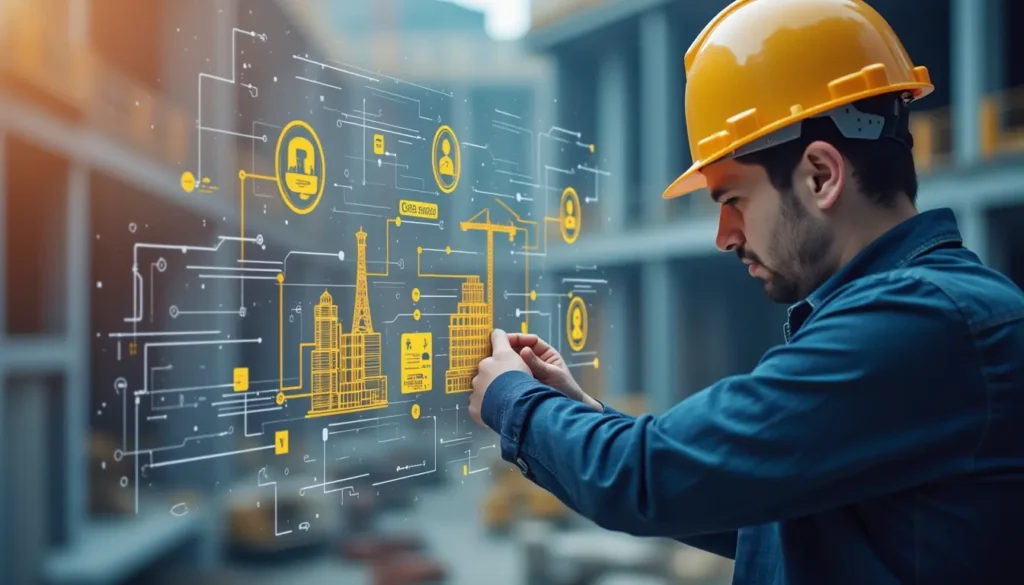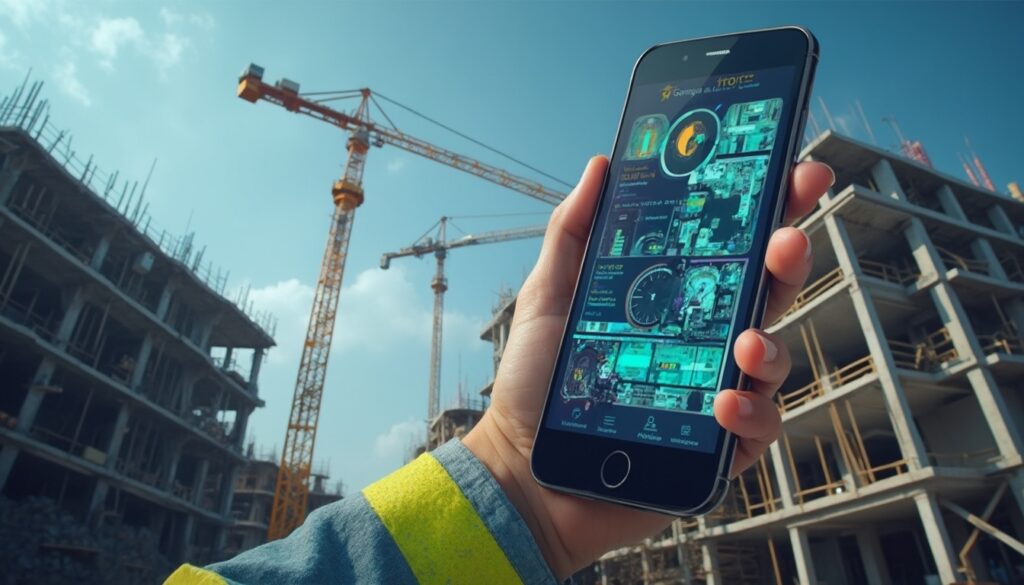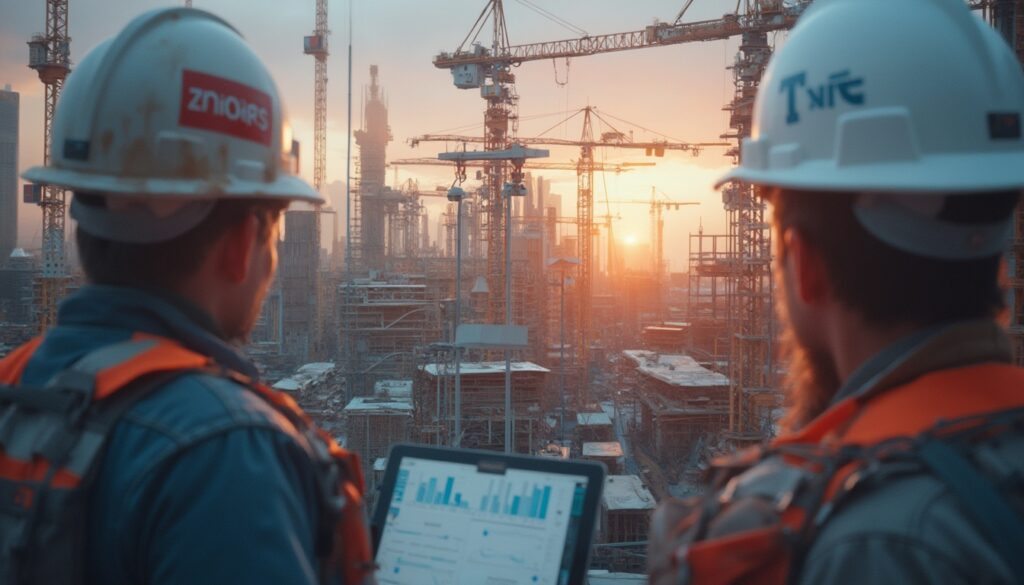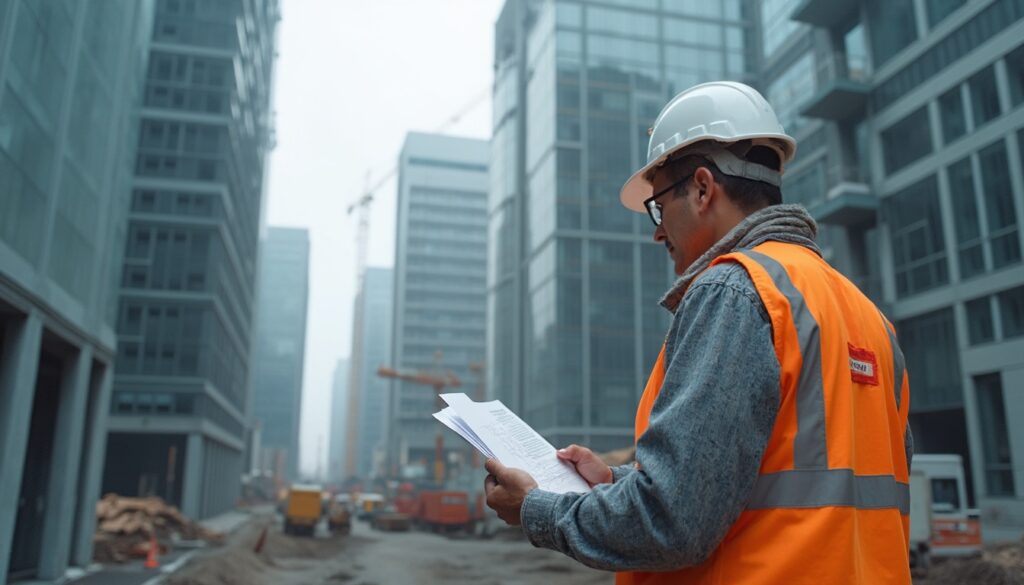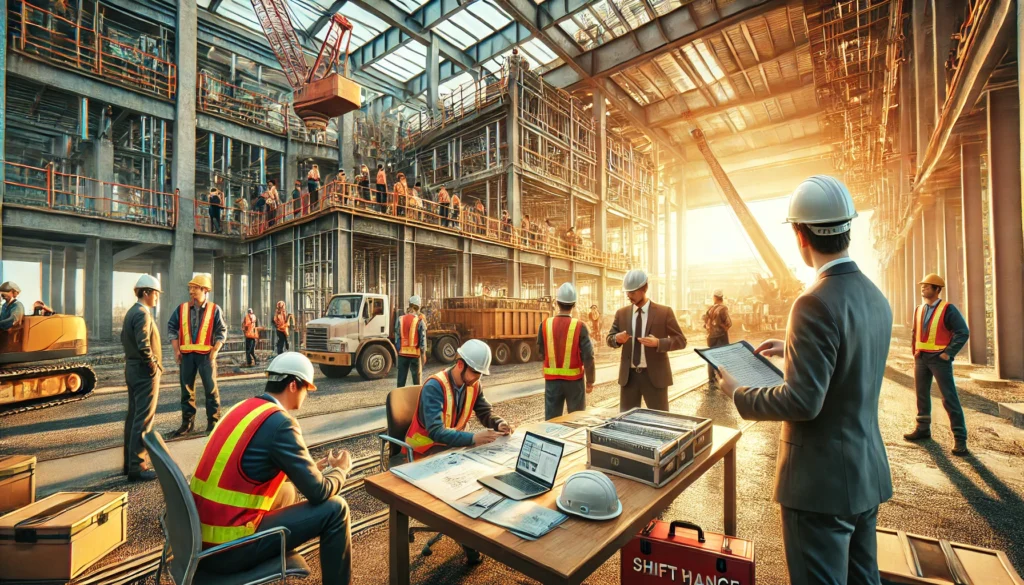Building for Tomorrow: How we shape the housing construction of the future in a human and innovative way
When we talk about the housing construction of the future , we’re discussing significant changes that are much more than just erecting buildings. We aim to create living spaces that truly meet the complex demands of our dynamically changing society. In light of urbanization, demographic change, and increasing environmental awareness, fresh ideas and new technologies are needed more than ever. Our conviction is clear: The future of housing, and thus the housing construction of the future, requires innovative, sustainable, and flexible solutions. In this article, we want to take a closer look at key aspects such as digitalization, sustainability through approaches of the sustainable construction industry, flexible living models, the tricky question of affordability, and the great potentials of communal living. We at Valoon understand these complex tasks all too well and provide you with tools to efficiently manage communication and project management processes in the construction sector, specifically for the housing construction of the future, to make them efficient. Let’s discover together how you can prepare your company for the future.
- Der housing construction of the future creates living spaces that meet the complex demands of a changing society.
- Innovative, sustainable, and flexible solutions are essential in light of urbanization, demographic change, and environmental awareness.
- Key aspects include digitalization, sustainability, flexible living models, affordability, and communal living.
- Valoon supports efficient communication and project management tools in future-oriented housing construction.
Let’s tackle it: Mastering challenges and trends in the housing construction of the future
Current challenges in housing construction
The construction industry is facing some serious challenges that significantly impact the housing construction of the future . Exploding energy prices, severe material shortages, and ongoing supply chain issues exacerbate the already existing housing shortage, especially in our cities and metropolitan areas. In addition, there are rising construction costs, which are further fueled by uncertain funding programs and often truly restrictive building regulations, as current analyses show (a look here is worth it: ). The European construction economy also suffers from relatively high interest rates and material prices, as well as a general reluctance to invest – experts even believe that housing construction will not recover significantly until 2026 (). All these factors make it clear: We need new strategies for the housing construction of the future.
Understanding changing housing trends as an opportunity
But hey, along with all the challenges, there are also exciting new housing trends that will shape the housing construction of the future . The demand for individualization and multifunctionality is growing; flexible spaces that can easily adapt to home office scenarios or co-working are in higher demand than ever. Additionally, intergenerational living models are gaining importance – they promote communal living across generations and create great social synergies. Another very important trend is – connected, smart properties that rely heavily on energy efficiency and Ambient Assisted Living (AAL) to enable older or support-needy individuals to live independently. The Trends in the construction industry clearly point towards intelligent and adaptable housing concepts for the housing construction of the future.
Government mandates and the reality of the market
The federal government has set ambitious goals: 400,000 new apartments annually, of which 100,000 are social housing. However, this target for the housing construction of the future is, to be honest, a real Herculean task in light of global developments, the mentioned challenges, and the need for innovative, often yet-to-be-tested housing models. All stakeholders must truly pull together to make significant progress and meet the pressing demand for housing. housing construction of the future .Without bits and bytes, nothing works: The digital infrastructure as the foundation of future construction
Broadband expansion and 5G as the basis for innovation
Honestly, a powerful digital infrastructure is no longer a nice extra today, but a fundamental requirement for the housing construction of the future. The comprehensive expansion of broadband networks and the rapid introduction of the 5G mobile standard are absolutely crucial to fully leverage the potential of modern technologies for the housing construction of the future . This infrastructure enables the networking of buildings, the integration of smart systems, and data-driven services – all of which are essential for energy-efficient and comfortable living. Without a solid digital foundation, many innovative concepts for the digital construction future unfortunately remain just theory.
- A robust digital infrastructure, including broadband expansion and 5G, is the fundamental basis for the housing construction of the future.
- Smart home technologies and logistical automation must be integrated into planning from the outset.
- The development of smart quarters with digital solutions for mobility, energy, and local services is crucial.
Driving the integration of smart living ecosystems
For the housing construction of the future , we must think about smart home technologies and logistical automation from the very beginning. This includes intelligent sensors that capture environmental data, connected controls for heating, lighting, and security, as well as systems for automatic ordering or smart shopping with augmented reality. The big question is, of course, how we can establish viable business models and strategic partnerships to utilize the data generated by these integrated systems in a value-adding way – even when it comes from unexpected competitors such as smart refrigerators. The digitalization of the construction industry plays a key role here for the housing construction of the future.
Establishing smart quarters as intelligent urban solutions
We as a housing construction company can truly lead the way and develop smart quarters for the housing construction of the future by implementing digital solutions for mobility, energy supply, and the organization of local businesses and services. This means encouraging sharing models for vehicles or resources and ensuring fair, transparent digital structures for the residents. For such quarters, KfW energy-efficient houses are ideal, and KfW construction supervision is often essential for their realization. These smart quarters must, of course, be designed to be energy-efficient and environmentally friendly while fostering local innovation ecosystems to make the housing construction of the future sustainable.Living as we want: Flexible and communal models for new lifestyles
Micro-living and space efficiency: Maximizing benefit in minimal space
The trend towards micro-properties? It challenges us in the housing construction of the future and demands advanced architectural designs, which make optimal use of every square meter. The focus is on multifunctional furniture that can flexibly adapt to different needs, vertical living solutions to better utilize height, and innovative storage systems that keep things organized. Modular designs are becoming increasingly important for the housing construction of the future, as they allow apartments to be flexibly adapted to changing life situations, such as easily reshaping floor plans. Such concepts are particularly relevant in densely populated cities, where living space is scarce and expensive. The future of the construction industry will be significantly shaped by such space-saving solutions.
Floating Homes: Innovative Living on Water
And then there are the floating apartments, the so-called Floating Homes – a super exciting topic for the housing construction of the future! However, this requires specific know-how in areas such as ship architecture, shipbuilding, and sustainable water management. These structures often need to be autonomous in terms of energy and water. This means using advanced filtration systems and renewable energy systems like photovoltaics or small wind turbines. An important consideration in planning is also to take climate change into account, especially rising sea levels and increasing extreme weather events, so that these forms of housing remain stable and safe as part of the housing construction of the future .
Collaborative Living: Living together, sharing resources
It’s great to see how shared apartments (WGs) and other forms of collaborative living are making a real comeback and establishing themselves as a sustainable and socially attractive housing model for the housing construction of the future . The core of these concepts is to maximize generous shared spaces (like kitchens, living rooms, work areas, gardens) while minimizing pure private retreat spaces. This leads to significant savings in space and energy per person compared to traditional individual apartments. There is a huge variety of models tailored to different population groups: senior WGs that enable mutual support in daily life, family-friendly cluster apartments, or multi-generational houses that promote exchange and cohesion. These approaches are a great response to increasing individualization and at the same time the desire for community in the housing construction of the future.
Benefits of Collaborative Living
The benefits of communal living are clear and make this model so attractive for the housing construction of the future:
- Resource efficiency: Shared appliances, spaces, and vehicles reduce individual consumption and spare the environment.
- Social interaction: Joint activities and mutual support counteract loneliness and strengthen the sense of community.
- Cost savings: Shared rent and additional costs often make living more affordable, especially in expensive cities.
Building greener, living better: Sustainability and circular economy as the core
Circular economy in the construction industry: A paradigm shift
When we talk about the housing construction of the future When we talk about it, we cannot overlook the circular economy – we must clearly commit to it. This means that building materials should ideally be 100% recyclable and should be returned to high-quality, sustainable material cycles after their useful life. We aim to avoid mountains of waste, conserve our precious resources, and drastically reduce the environmental impact of the construction sector. The development of a model, as discussed in studies, could provide transparency and promote the reuse of building components. This approach requires a genuine rethink in planning, material selection, and deconstruction concepts for the housing construction of the future.
- The circular economy aims to make building materials fully recyclable and minimize waste in the housing construction of the future .
- The use of green building materials such as wood from sustainable forestry, hemp, or recycled materials is central.
- Bionic architecture uses principles from nature for energy-efficient, resource-saving, and stable construction.
Green building materials: Using nature as a model
The use of plant-based materials, recycled materials, and bio-based composites plays a key role in creating a more sustainable housing construction of the future. Wood from sustainable forestry, insulation materials made from hemp or cellulose, clay construction, and recycled materials such as recycled concrete are great examples of more environmentally friendly alternatives. When selecting, it’s important to conduct a comprehensive life cycle analysis that considers the environmental impacts of material extraction, production, transportation, use, and disposal . sustainable construction industry is increasingly relying on such innovative and resource-saving materials in housing construction of the future.
Bionic architecture: Learning from nature for sustainable design
Have you ever heard of bionics? That is, learning from nature (biomimicry)? This offers us incredibly fascinating approaches for a sustainable building design in housing construction of the future. Examples include facades inspired by the self-cleaning properties of plant leaves (the famous lotus effect), or building structures inspired by natural construction principles to save materials and increase stability. The integration of natural ventilation systems, the use of passive solar heating through intelligent building orientation, and the implementation of rainwater harvesting systems are additional elements of bionic architecture that contribute to energy efficiency and resource conservation. Such approaches impressively demonstrate how construction industry future technology and nature can harmoniously connect. housing construction of the future Housing for all: How we secure affordability and social responsibility in future housing constructionMastering the challenge of affordability
One of the big nuts we must crack is the balancing act between affordability and sustainability. We need to create housing that not only meets ecological requirements but is also financially accessible to broad population groups. This requires innovative financing models, an optimized cost structure in the construction process, and a fair distribution of burdens. The study by BBSR emphasizes how complex this task is and that we need comprehensive solutions for the
that consider the entire life cycle of a building. housing construction of the future knacken müssen, ist dieser Spagat zwischen Bezahlbarkeit und Nachhaltigkeit. Wir müssen es schaffen, Wohnraum zu bauen, der nicht nur ökologischen Anforderungen genügt, sondern den sich auch breite Bevölkerungsschichten finanziell leisten können. Das erfordert innovative Finanzierungsmodelle, eine optimierte Kostenstruktur im Bauprozess und eine faire Verteilung der Lasten. Die Studie des BBSR unterstreicht, wie komplex diese Aufgabe ist und dass wir ganzheitliche Lösungen für den housing construction of the future Stakeholder cooperation as the key to success
For the
Damit der housing construction of the future to truly be socially responsible and successful, it can only be achieved through close and trustful collaboration of all parties involved. Housing companies, private investors, architects and planners, as well as municipalities must all pull together. Only through integrated planning approaches, transparent communication, and shared responsibility can projects be realized that are both economically viable and socially just and ecologically sustainable. The cooperation partners in future housing must find new ways of collaboration for the housing construction of the future .
Applying pragmatism in standards and regulations
And one more important point for affordable housing construction of the future: We need a pragmatic approach to standards and technical regulations. High standards are certainly important for quality and safety, no question. But an excessive or overly rigid interpretation can unnecessarily drive up construction costs and block innovative, cost-effective solutions. A careful consideration is needed regarding which standards are truly essential, and where flexibility or alternative proof methods may be possible, without jeopardizing basic quality requirements. A focus on CO2e reduction rather than rigid individual building efficiency standards could open up new pathways for the housing construction of the future .
Prioritizing long-term affordability over short-term returns
Especially when it comes to social housing and the creation of permanently affordable housing, it must be clear: The long-term affordability for tenants is more important than quick returns for investors. This may require new funding instruments, alternative ownership models, or a stronger role for community-oriented housing companies. The housing construction of the future must ensure that housing remains a basic right and does not become a luxury good. Actively promoting and financially supporting the preservation of affordable housing by extending occupancy ties is a crucial lever.Building smarter, living better: Technology and innovation as a driver for efficiency
Smart home technologies for greater energy efficiency and comfort
Mit With smart home devices and systems we can really achieve a lot in the housing construction of the future both in terms of energy efficiency and living comfort. Through the development and implementation of advanced algorithms for automated climate control, intelligent lighting systems, and demand-oriented device optimization energy consumption can be significantly reduced. At the same time, user comfort increases through personalized settings and intuitive operation concepts. However, we must always carefully consider the security and data protection implications of connected devices to ensure user trust. The AI in construction offers enormous potential for the housing construction of the future.
Consistently integrating renewable energies into residential buildings
If we truly want to handle energy sustainably, we must solar panels, geothermal energy, and solar thermal energy naturally plan for in the housing construction of the future . The development of advanced energy storage solutions, such as battery storage, and the establishment of smart grids are essential to maximize self-consumption of renewable energies and stabilize the power grid. The use of plus-energy house concepts, where buildings generate more energy than they consume, is an ambitious but super important step towards climate neutrality in the housing construction of the future. The AI in the construction industry can help us optimally control these systems.
Using hybrid heating systems as a flexible transitional solution
Hybrid heating systems are a really clever transitional solution on the way to 100% renewable heat im housing construction of the future. These systems intelligently combine renewable energy sources, such as heat pumps or solar thermal energy, with traditional heating systems, such as gas condensing boilers. This allows the most cost-effective and environmentally friendly heat source to be utilized, depending on availability and efficiency. The use of green hydrogen or synthetic climate gases in conjunction with fuel cells could be another exciting option in the future to further reduce environmental impacts in the housing construction of the future .
Important technologies at a glance
For the housing construction of the future Some technologies are particularly exciting:
- Smart Metering: Intelligent meters that allow us to capture and optimize energy consumption in detail.
- Building automation: Connected systems that automatically control heating, ventilation, lighting, and shading.
- Predictive maintenance: Sensor-based monitoring of systems to detect maintenance needs early – this significantly influences the construction industry future technology .
That’s how it’s done: Inspiring examples and case studies for the housing of tomorrow
Building Culture Workshop Iphofen 2016: Impulses for affordable and high-quality construction
Does anyone still remember the? It was all about: forward-looking, affordable, and high-quality housing construction, that is, the housing construction of the future. Central topics back then included the serial and modular construction as a means of increasing efficiency, the innovative use of wood as a sustainable building material, as well as aspects of sustainability and flexibility in floor plan design. Strategies for urban densification and the creation of social housing were also intensely discussed. Such events are super important to identify best practices and advance the discourse on the housing construction of the future .
Adaptive reuse projects: Rethinking existing structures
Let’s take a look at Hong Kong: Projects like the ‘Tai Kwun Center for Heritage & Art’ and ‘PMQ’ are excellent examples of the adaptive reuse of existing building stock. They impressively show how historical or vacant buildings can be transformed into vibrant, multifunctional spaces through creative repurposing concepts. This approach is not only sustainable because it conserves resources and retains gray energy, but also creates unique places with strong identity – an important aspect for the bestehender Bausubstanz. Sie zeigen eindrucksvoll, wie historische oder leerstehende Gebäude durch kreative Umnutzungskonzepte in lebendige, multifunktionale Räume verwandelt werden können. Dieser Ansatz ist nicht nur nachhaltig, weil er Ressourcen schont und graue Energie erhält, sondern schafft auch einzigartige Orte mit starker Identität – ein wichtiger Aspekt für den housing construction of the future, which must think beyond mere new construction. The conversion of office spaces into residential units, as mentioned in the Research Input, is a concrete example that we could see more often in housing construction of the future .
Tiny houses: Minimalism as a living trend
And then there are of course the tiny houses – the hype surrounding the tiny homes (living spaces up to 45 square meters) as an alternative to traditional single-family homes just won’t die down and reflects a desire for a reduced, resource-saving lifestyle. The range extends from simply converted trailers to architecturally impressive new buildings that showcase the housing construction of the future in small form. While tiny houses work great in rural areas or as vacation homes, their integration into dense urban environments poses a challenge due to the high space requirement per unit – unless one considers vertical stacking concepts. Nevertheless, they provide important impulses for the housing construction of the future, especially regarding space efficiency and sufficiency.
Criteria for successful best practices
Successful projects in housing construction of the future often share a few common characteristics:
- User orientation: The needs of the people who will later live there are at the center of planning.
- Willingness to innovate: Openness to new technologies, materials, and construction methods.
- Holistic approach: Ecological, economic, and social aspects are taken into account throughout the entire life cycle.
Let’s tackle it together: This is how we actively shape the housing construction of the future!
When we look at all the diverse trends and challenges, one thing becomes clear: The housing construction of the future requires a real rethink and bold, fresh ideas. From digital transformation to sustainable building methods and flexible housing models to ensuring affordability – the tasks are complex and interconnected. Everyone really must pull together: politics, business, academia, and all of us as a society, to set the right course and create livable, future-proof housing for all within the framework of the housing construction of the future . The integration of technologies such as artificial intelligence in the construction industry and the consistent implementation of the digitalization of the construction industry are absolutely essential. We must now translate the insights from studies like the one by BBSR into practice.
We at Valoon are firmly convinced: An optimized communication and really good project management are worth their weight in gold. That’s exactly where we come in with our software solutions: We transform everyday messenger communication into structured project data and help you break down information silos, improve collaboration between the office and the construction site, and successfully implement your projects in the housing construction of the future . By simplifying data collection and sustainably optimizing information flow, we ensure that you can focus on what matters: the creation of high-quality and future-proof living space, the core of housing construction of the future.
Der housing construction of the future is a task that we can only tackle together. Simply get in touch with us today to find out how Valoon can support you with your projects and how together we can revolutionize the construction industry. Register for a demonstration and discover the benefits of our innovative platform for your company. Let’s shape the future of living together – efficiently, sustainably, and tailored to the needs of people, as part of housing construction of the future. Visit our Contact page, to take the first step.
How can Valoon help my construction company increase efficiency in the future housing industry?
Valoon optimizes your construction projects by simplifying the communication between field staff and office drastically. By using familiar messengers like WhatsApp for data collection, information is collected faster and more systematically , saving time and reducing errors.
What role does digitalization play for my company in the future housing industry, and how does Valoon support this?
Digitalization is essential for competitiveness. Valoon is your bridge to simple digitalization: We automatically convert unstructured communication (e.g., photos, voice messages via WhatsApp) into usable project data , without your employees having to learn complex new software.
How does Valoon support the implementation of sustainable construction projects and the use of new materials?
For sustainable projects, comprehensive documentation is essential. With Valoon, you can easily and directly document the use of ecological materials or the installation of renewable energy technologies from the construction site, which improves traceability and reporting.
Can we also optimize communication with Valoon in flexible or modular building methods?
Yes, especially in flexible and modular building methods that often require quick adjustments and close coordination, Valoon ensures a smooth flow of information. Changes and progress can be shared and documented in real time , significantly improving coordination.
How does Valoon help increase the acceptance of new digital tools among my field staff?
Valoon focuses on user-friendliness and the integration of common messenger services such as WhatsApp. Since your employees can use familiar tools, lengthy training sessions are eliminated, and the acceptance of digital processes increases significantly..
The future of residential construction calls for smart home integration. How can Valoon support this?
The installation and maintenance of smart home technologies require precise documentation. Valoon enables your teams to capture installation steps, test results, and handover protocols directly via messenger and store them centrally, supporting quality assurance.
How can Valoon help counteract the shortage of skilled labor through more efficient processes?
By automating and simplifying administrative tasks such as reporting and data entry,your skilled workers gain valuable time back. They can use this for their core tasks, which increases overall efficiency..
Does Valoon also support multilingual teams, as often found in residential construction?
Yes, Valoon offers an automatic translation feature in over 50 languages. This is a great advantage for internationally structured teams or when collaborating with subcontractors from different backgrounds and eliminates language barriers..

